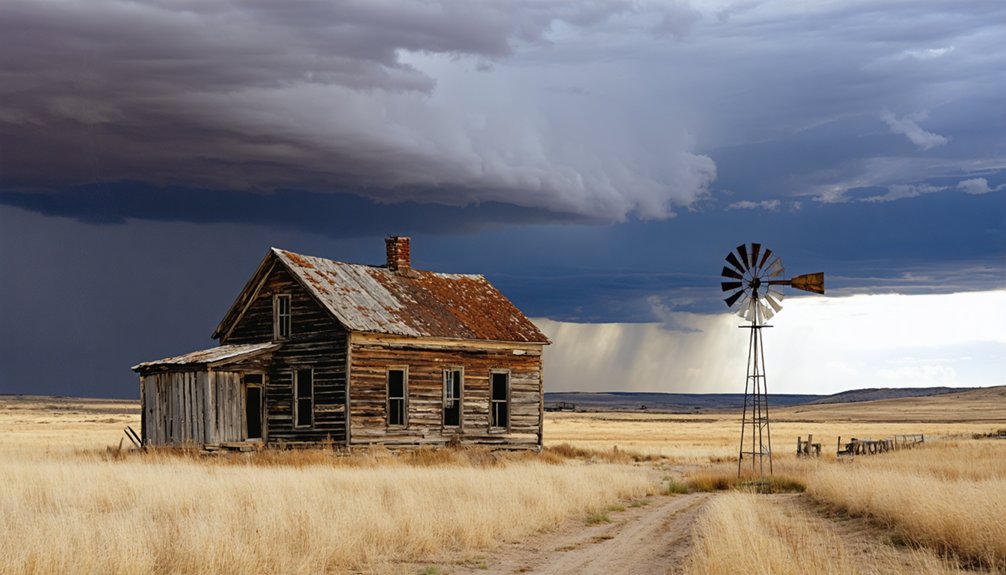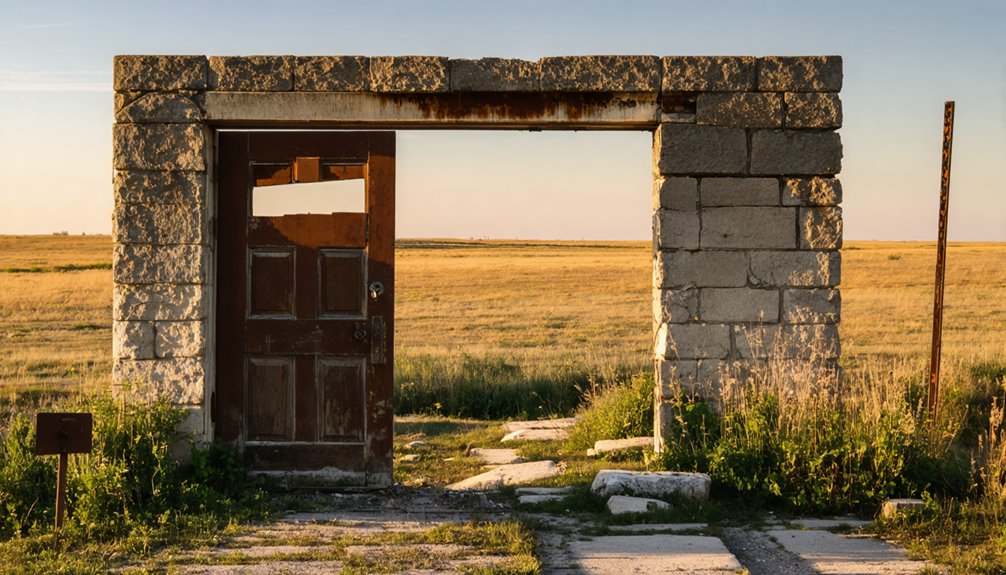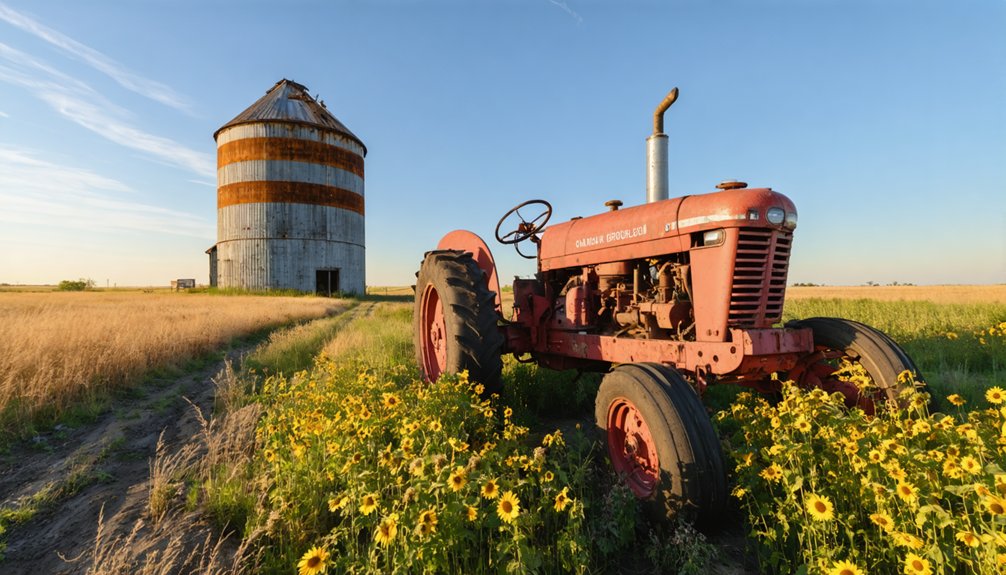You’ll find Okobojo’s remains in Sully County, South Dakota, where Peter Brennan first settled in 1882 before the official land opening. During the Dakota Boom, this frontier town grew to 250 buildings, including a general store, hotel, and printing office. By the late 1880s, severe crop failures and high fuel costs forced businesses to close and families to leave. Today, only scattered foundation stones peek through prairie grass, while the cemetery near Onida preserves the settlers’ stories.
Key Takeaways
- Okobojo was established in 1882 by Peter Brennan and quickly grew to 250 buildings, including stores, hotels, and community services.
- The town’s name comes from a Native American word meaning “to plant in spaces,” reflecting its agricultural aspirations.
- Severe crop failures beginning in 1886 and high operational costs led to business closures and population decline throughout the 1890s.
- By the early 1900s, Okobojo had become a ghost town, with most structures abandoned and the land reclaimed by prairie grass.
- Today, only foundation remnants and a nearby cemetery in Onida preserve the memory of this former frontier settlement.
Origins and Early Settlement Days
While many settlers rushed to claim land in Dakota Territory during the 1880s, Peter Brennan blazed the trail to Okobojo in early 1882, arriving before the official government land opening.
You’ll find that most early settlers came from industrial states like Iowa, Ohio, Illinois, and Indiana, with settler motivations largely focused on temporary opportunities rather than permanent homesteading.
Originally called Pymosa, the township’s adoption of the Dakota name Okobojo, meaning “to plant in spaces,” reflected the indigenous influence on the region.
By October 1883, you’d have seen about 250 buildings dotting the landscape, including a general store, hardware shop, hotel, and slaughterhouse.
The town’s rapid development also brought essential community features like a printing office, cemetery, and town hall.
The Rush to Prairie Land
As you trace Okobojo’s early growth, you’ll find its rapid expansion mirrored the larger Dakota Boom of the 1880s, when railroad access and favorable land policies drew waves of hopeful settlers to the northern prairies.
The township’s population swelled as homesteaders, taking advantage of the 1862 Homestead Act‘s promise of free or cheap land, staked their claims and established farms across the previously open grasslands. These pioneers joined the massive migration that saw 79 percent immigrant families establishing new lives in the Dakota Territory.
You can see how this settlement rush transformed the area from pristine prairie to agricultural development, as new residents invested their labor in breaking the tough prairie sod and creating the infrastructure of a growing farm community. This development happened around the same time that the Treaty of Fort Laramie was being violated as miners flooded into the Black Hills region.
Land Opening Draws Settlers
Through a series of pivotal treaties in the 1850s, millions of acres of Dakota prairie land became available to American settlement. The 1851 Treaty of Traverse des Sioux revealed 30 million acres east of the Big Sioux River, while the 1858 Treaty of Washington created a massive 14-million-acre triangle for land acquisition between the Big Sioux and Missouri Rivers.
You’ll find early settlement patterns concentrated along waterways, with pioneers establishing riverside communities like Yankton, Vermillion, and Sioux Falls. The Lakota and Dakota tribes were gradually displaced as settlers moved into these regions.
Though initial migration remained slow due to the nation’s focus on slavery debates and western gold rushes, Congress’s establishment of Dakota Territory in 1861 formalized your path to ownership. The newly formed territory saw a surge in population through the Dakota Boom period between 1880 and 1890.
Rapid Township Population Growth
Since the establishment of Dakota Territory in 1861, Rapid City has experienced remarkable population growth, transforming from a modest prairie settlement into a thriving regional hub.
You’ll find population trends showing dramatic expansion, with the city’s numbers surging from 74,703 in 2020 to 84,930 by 2024 – a striking 13.7% increase.
Urban migration patterns reveal a consistent flow of residents seeking better opportunities, as the city’s growth rate outpaces South Dakota’s statewide average. The most recent data shows a 3.05% population increase from 2023 to 2024.
The statistics tell a compelling story: the city’s population has doubled since 1950 and quadrupled since 1920.
Today, you’re witnessing a continuing shift as young, working-age people leave rural areas for Rapid City’s economic advantages, contributing to the city’s role as a dominant regional center.
The city’s position in western South Dakota has made it an ideal gateway for both commerce and tourism in the region.
Building a Community From Scratch
When Peter Brennan arrived in early 1882, he couldn’t have known he’d spark the birth of Okobojo, South Dakota. Through sheer pioneer spirit, settlers from Iowa, Ohio, Illinois, and Indiana transformed empty prairie into a thriving township. Their community resilience showed in how quickly they established essential infrastructure.
From untamed prairie to bustling township, brave pioneers from across America’s heartland built Okobojo through determination and shared vision.
By October 1883, you’d have witnessed an impressive transformation:
- Over 250 buildings dotted the landscape, including a general store, hardware shop, and hotel.
- A newly built schoolhouse stood proudly on the west side, prioritizing education.
- Essential services emerged with a slaughterhouse, printing office, and town hall.
The name Okobojo, meaning “to plant in spaces,” reflected the settlers’ agricultural dreams. They created more than buildings – they forged a community with shared civic values, demonstrated through their newspaper, cemetery, and diverse business district.
Daily Life in 1880s Okobojo
If you’d visited Okobojo in the 1880s, you’d have found families deeply engaged in daily farm work, tending to crops and livestock while maintaining household gardens for self-sufficiency.
You could’ve purchased essentials at the general store or hardware store, picked up mail at the post office, or caught up on local news at the printing office. The town’s main street would have resembled the authentically preserved 1880 Town buildings established years later near Exit 170.
Your social interactions would’ve centered around school events, communal harvests, and gatherings at the town hall, where residents maintained strong bonds despite their relative isolation. Many early settlers came from Iowa and Ohio, seeking new opportunities in the Dakota Territory.
Pioneer Daily Routines
As harsh prairie winds swept across Okobojo in the 1880s, pioneer families followed strict daily routines that began before sunrise and stretched well past sunset.
Your pioneer chores would’ve varied with each passing season, from spring planting to autumn harvest, leaving little time for rest. Women tackled household duties while men worked the fields, and children pitched in wherever needed.
Your daily tasks would’ve included:
- Drawing precious water from wells before breakfast to sustain your family and livestock
- Tending to crops and animals through blistering heat or bitter cold, knowing your survival depended on it
- Preserving food through smoking, salting, or storing in root cellars to guarantee winter sustenance
These seasonal tasks demanded grit and determination, defining the rhythm of life in Okobojo’s untamed frontier.
Community Social Activities
The rhythmic thump of boot heels against wooden floorboards echoed through Okobojo’s community gatherings in the 1880s, where you’d find yourself swept up in a vibrant social scene despite the town’s remote prairie location.
You could join your neighbors at harvest festivals, barn dances, and holiday celebrations that brought warmth to the harsh Dakota territory.
Social gatherings centered around the town’s essential institutions – the church, school, and town hall.
You’d exchange news at the post office, catch up on local happenings through the newspaper, and participate in quilting bees during winter months.
Even when facing challenges like crop failures or severe weather, community resilience shone through as residents supported one another.
Three Finley family households maintained their presence in the area long after most residents had departed, preserving the legacy of the original settlers.
From baseball games to barn raisings, these shared experiences created lasting bonds that sustained Okobojo’s spirit until its final days.
The town’s general store became a popular meeting spot where settlers from Iowa, Ohio, and Illinois would gather to share stories of their homelands.
Businesses Serving Residents
Life in 1880s Okobojo revolved around a network of businesses that kept the prairie settlement running.
You’d find essential business services at the general store, where settlers purchased everything from dry goods to basic medicines. The hardware store supplied critical farming implements, while the slaughterhouse processed meat for the community before refrigeration became available.
To meet your community needs in this frontier town, you could:
- Get your local news and job printing done at the printing office
- Send and receive mail at the post office to stay connected with the outside world
- Stock up on tools, building materials, and daily necessities from local merchants
These businesses formed the backbone of Okobojo’s self-sufficient economy until poor crop yields in the 1890s forced many to close.
Economic Development and Local Business
During its brief heyday in the 1880s, Okobojo flourished with a diverse commercial district that included two hotels, a bank, and essential service providers.
You’d find a well-established general store, hardware shop, printing office, and slaughterhouse serving the growing population. The town’s entrepreneurial spirit attracted settlers from Iowa, Ohio, and other Midwestern states.
The community’s economic resilience showed in its innovative trading practices, where residents bartered eggs and farm goods for groceries. A flour mill launched in 1884, though high fuel costs later forced its closure.
Resourceful pioneers kept Okobojo’s economy alive through bartering, until even their entrepreneurial spirit couldn’t overcome mounting operational costs.
While Fort Sully’s military personnel boosted local commerce, Okobojo’s dependence on agriculture ultimately proved risky. By the 1890s, crop failures and limited manufacturing options led to the town’s decline, with businesses relocating or closing altogether.
Natural Challenges and Hardships

While early settlers like Peter Brennan optimistically claimed land near the Missouri River in 1882, Okobojo’s residents soon faced nature’s relentless challenges in Sully County’s rolling prairies.
By 1886, unpredictable weather patterns began wreaking havoc on farming efforts, leading to devastating crop failures that would eventually force many to abandon their homesteads.
You’ll find that Okobojo’s settlers encountered these harsh realities:
- Extreme temperature swings that made it impossible to maintain consistent crop yields
- Limited access to essential resources, including fuel for the flour mill
- Isolation that prevented quick supply runs during weather emergencies
Despite their determination, the community couldn’t overcome the environmental hurdles.
The land’s unforgiving nature, combined with insufficient infrastructure and distant supply routes, ultimately sealed Okobojo’s fate.
The Path to Abandonment
After experiencing promising early growth in 1883 with nearly 250 buildings and thriving businesses, Okobojo’s descent into abandonment began swiftly in 1886 when severe crop failures struck the region.
You’d have seen the town’s liveliness drain away as economic challenges mounted – the flour mill shut down due to high fuel costs, and agricultural failures forced families to seek opportunities elsewhere.
The exodus accelerated through the 1890s as extreme weather continued to devastate crops.
One by one, you would’ve witnessed businesses closing their doors, including the local newspaper which held out until 1929 before relocating to Onida.
The town’s dependence on farming proved disastrous, and by the turn of the century, Okobojo had transformed from a bustling frontier community into a ghost town.
What Remains Today

Today, if you visit the former site of Okobojo, you’ll find little evidence of its frontier-era prosperity. The barren landscape has been reclaimed by South Dakota’s rolling prairies, with native grasses and wildflowers covering what was once a bustling community.
While historical markers are scarce, ghost town exploration enthusiasts can still discover traces of the past.
For those seeking to experience Okobojo’s remains:
- The cemetery, located two miles from the main site, stands as the most tangible connection to the town’s history.
- Foundation remnants, though difficult to spot, occasionally peek through the prairie grass.
- The surrounding natural environment offers a glimpse of the landscape early settlers encountered.
The site remains largely undeveloped, drawing only occasional visitors interested in local history and ghost town adventures.
Historical Significance and Preservation
Beyond the physical remnants, Okobojo’s rich historical legacy speaks to a broader story of frontier settlement and community resilience.
You’ll find its historical importance reflected in the preserved cemetery near Onida, which stands as a tribute to the pioneering spirit of its early settlers from Iowa, Ohio, Illinois, and Indiana.
The community legacy lives on through oral histories and local preservation efforts by Sully County residents.
The town’s Dakota name, meaning “to plant in spaces,” captures the agricultural ambitions that drew settlers west.
Despite challenges like crop failures and harsh weather that led to its abandonment by 1890, Okobojo’s story of cultural significance – from its literary societies to community dances – exemplifies the determination of frontier communities in South Dakota’s formative years.
Frequently Asked Questions
What Happened to the Original Residents After Leaving Okobojo?
You’ll find original residents from this ghost town history scattered mainly to Iowa, Ohio, Illinois, and Indiana, while others moved to nearby South Dakota towns like Onida seeking better economic opportunities.
Are There Any Living Descendants of Okobojo’s First Settlers Today?
While historical records don’t confirm specific living descendants, you’ll find family genealogy research shows some settlers’ bloodlines continue today, though they’re scattered across America rather than concentrated in Sully County.
Were There Any Notable Crimes or Law Enforcement Issues in Okobojo?
You won’t find detailed crime statistics or formal law enforcement records from Okobojo’s brief history, though the town’s remote location and small population likely meant minimal criminal activity.
Did Native American Tribes Interact With the Okobojo Settlement?
You’ll find evidence of Native American interactions through cultural exchanges with early settlers, as Sioux tribes maintained trade routes near Okobojo during its settlement after 1883.
What Items or Artifacts Have Been Recovered From the Okobojo Site?
You’ll find Native American arrowheads, flint tools, early homesteader relics, 1930s car parts, and post office remnants. The artifacts’ discovery reveals significant historical layers spanning prehistoric to pioneer periods.
References
- https://en.wikipedia.org/wiki/Okobojo
- https://kxrb.com/no-not-okoboji-its-okobojo-south-dakota/
- http://www.okobojo.com
- https://www.thedakotascout.com/p/central-south-dakota-county-looks
- https://www.youtube.com/watch?v=wEnmrOV1fAI
- https://www.ghosttowns.com/states/sd/okobojo.html
- http://www.okobojo.com/xfrom root/Guestbook/guestbook_main.htm
- https://espnsiouxfalls.com/you-know-okoboji-iowa-how-about-okobojo-south-dakota/
- https://commons.und.edu/cgi/viewcontent.cgi?filename=10&article=1000&context=oers&type=additional
- https://www.americanhistorycentral.com/entries/black-hills-gold-rush/



